It’s Monday, April 14, 2025 and 88°F in Austin, Texas
My Favorite Semi-Precious Stones for Hardstone Animals
Here are some images showing my favorite semi-precious stone animals from my collection
 I started a collection of hardstone animals, eggs and boxes during my first trip to Russia in 1976. I found a box of 20 eggs carved in various Russian stones in a Beriozka shop in Leningrad. Beriozka (Birch Tree) Shops were hard currency stores in Russia. This box cost me around $200 - I was very poor at the time and this was really expensive for me. This collection was a real treasure form and I used to hold the eggs and think about being in Russia. because I was in the travel business I was able to go back to Russia several times a year. I usually went in Winter because it was cheaper. I used to take big and small groups to Russia, the largest was over 100. Russia became a second home to me because I had always been in love with its history music and culture, even since I was a kid. Reader's Digest wrote an article about me called "The Boy Who Dreamed of a Palace" about my fascination with the Romanovs. Anyway, every time I went to Russia I tried to come back with more hardstone eggs and boxes. I was even able to find a few miniature hardstone vases. Since I loved Russia and the Romanovs it's not a surprise that I loved Fabergé, too. Since I was a poor working travel agent I could never afford original Fabergé animals so I decided to commission 'copies'. I was able to get a few things in St. Petersburg, but they were very expensive. I used to buy them at the Demeyon Shop on Nevsky Prospect or Ananovs on Michurinskaya.
I started a collection of hardstone animals, eggs and boxes during my first trip to Russia in 1976. I found a box of 20 eggs carved in various Russian stones in a Beriozka shop in Leningrad. Beriozka (Birch Tree) Shops were hard currency stores in Russia. This box cost me around $200 - I was very poor at the time and this was really expensive for me. This collection was a real treasure form and I used to hold the eggs and think about being in Russia. because I was in the travel business I was able to go back to Russia several times a year. I usually went in Winter because it was cheaper. I used to take big and small groups to Russia, the largest was over 100. Russia became a second home to me because I had always been in love with its history music and culture, even since I was a kid. Reader's Digest wrote an article about me called "The Boy Who Dreamed of a Palace" about my fascination with the Romanovs. Anyway, every time I went to Russia I tried to come back with more hardstone eggs and boxes. I was even able to find a few miniature hardstone vases. Since I loved Russia and the Romanovs it's not a surprise that I loved Fabergé, too. Since I was a poor working travel agent I could never afford original Fabergé animals so I decided to commission 'copies'. I was able to get a few things in St. Petersburg, but they were very expensive. I used to buy them at the Demeyon Shop on Nevsky Prospect or Ananovs on Michurinskaya.
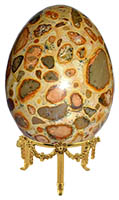 I found some guys in China who started making stuff for me - this was 20 years ago - and it took a few years to put commission and deliver around 30 pieces. I was able to have the made in the semi-precious stones I already loved. Going through the process of selecting models, finding the stones, carving the animals and sending them to the USA I can share with you some of the experiences I had that might help you pick stones for your own. You'll be able to learn about some of the problems I had and avoid them.
I found some guys in China who started making stuff for me - this was 20 years ago - and it took a few years to put commission and deliver around 30 pieces. I was able to have the made in the semi-precious stones I already loved. Going through the process of selecting models, finding the stones, carving the animals and sending them to the USA I can share with you some of the experiences I had that might help you pick stones for your own. You'll be able to learn about some of the problems I had and avoid them.
So, I hope you enjoy seeing these animals and the beautiful stones they are in. There was a time when it was easy to commission beautiful things from China. I had to stop because I had run out of room for these things and it because to difficult and expensive to order them.
I have posted a bunch of horses -having the same animal means you can compare and contrast the stones. That's one of the reasons I commissioned them. I now have a 'herd' of them assembled in formation on a beautiful pietra-dura table from Timothy Corrigan's collection.
If you want to post questions to me you can in the comments area at the bottom of the article and I'll respond there - or you can email me.
Bob Atchison
 Green Aventurine Shire Horse with Ruby Eyes in Gold Collots
Green Aventurine Shire Horse with Ruby Eyes in Gold Collots
It is impossible to fully describe the appearance of the translucent stone with its softly sparkling inclusions like stars in a fog. Aventurine is a variety of translucent quartz with abundant small plate- or flake-shaped inclusions. Light entering the quartz strikes these inclusions and reflects from them. This produces a sparkly appearance known as "aventurescence." The most common color of aventurine is green, but it may also be orange, brown, yellow, blue, or grey. Chrome-bearing fuchsite (a variety of muscovite mica) is the classic inclusion, and gives a silvery green or blue sheen. Oranges and browns are attributed to hematite or goethite. Aventurine quartz is very hard to carve and large pieces of it are hard to find. My carvers found the piece used to carve this 7-inch horse is a special Chinese mineral market, that was only held a few times a year. The ruby eyes look fantastic against the green-colored store.

Red Aventurine Shire Horse with Sapphire Eyes in Gold Collots
When I decided to find craftsmen to make my hardstone animals I showed them photographs of the famous Shire Horse made by Fabergé that is in the Royal Collection of her Majesty Queen Elizabeth. I wanted something as close to a copy as possible. The original is big for a Faberge animal, we still have the was model that was was made from real living horse on one of the Royal farms. It was impossible to find a piece of deep red aventurine. There was plenty of pink around, we could not find red. Well, it was not impossible, but it took two years to locate the stone and we located it in Russia. You think it would be easy for the Chinese to get the stone from Russia - since it was next door - but they asked be to buy it and send it to them, which I did. There are some inclusions and veins in this stone, but I think that adds to the beauty of it. You will remember that red aventurine gets its color from hematite. One of the problems we had making these horses was that the Chinese did not know what a shire horse was. They kept making 'pretty' race horses for me. Finally we got it right. I am glad I didn't stop pushing the carving studio to make this, after it was done we were never able to find another piece of red aventurine of this size. Fabergé usually placed his jeweled eyes in gold collots, so I did it for all of these horses I had made.
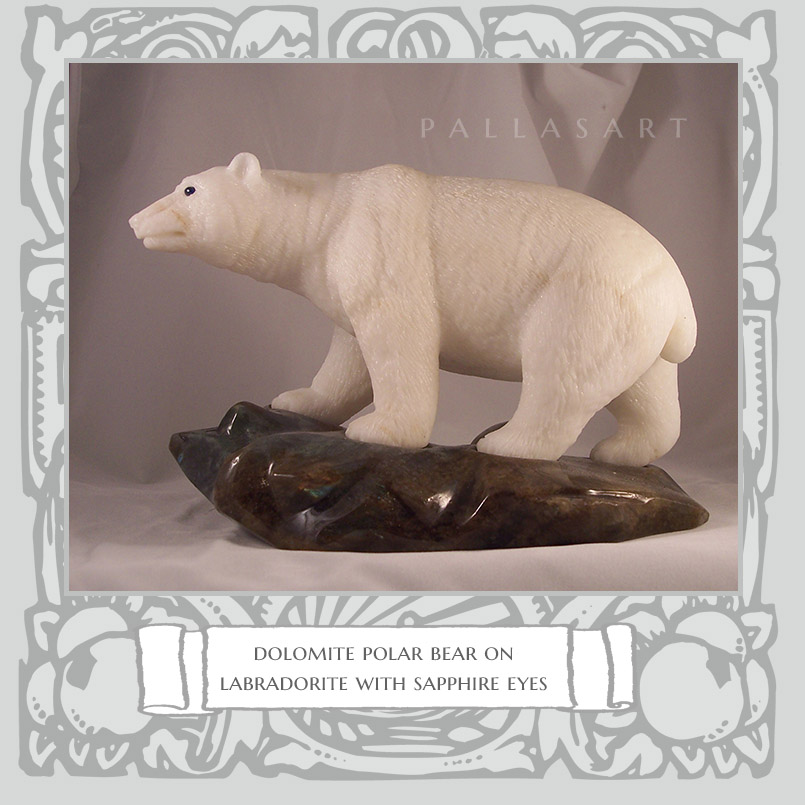
Dolomite Polar Bear on a Labradorite Base with Sapphire eyes in Gold Collots
I found a model for this polar bear in Canada and sent it to China to be carved. Dolomite is a mineral and a rock that has a unique saddle-shaped crystal. It is made up of calcium magnesium carbonate and most likely exists in sedimentary or metamorphic rocks. It is harder than marble, but softer than granite. Dolomite is commonly found in many European areas, Canada, and Africa. Although it is harder than marble It is relatively soft and has to be carefully handled because it is somewhat porous and can be scratched. The surface is almost matte, almost soapy with visible crystals that flash softly . Dolomite does not take a high shine like aventurine. The polar bear was carved with very fine fur. He stands on a massive piece of labradorite that looks like black ice with flashing Iridescence. He's big almost 9 inches long. The eyes are cabochon sky blue sapphires and they are set in tiny gold collots. This is my favorite animal in my collection.
 White Nephrite Shire Horse with Emerald Eyes in Gold Collots
White Nephrite Shire Horse with Emerald Eyes in Gold Collots
White nephrite is one of two types of Jade. White Nephrite comes in translucent white to very light yellow form which is known in China as mutton fat jade. Today most white nephrite use in carving comes from western Canada. This was one of Fabergé's favorite stones. The hardness of nephrite means it is very hard to carve and can take a very high polish. My nephrite horse has been made from a totally white stone with no inclusions or veins. It almost looks like it has been carved from milk glass. When I say 'carved' I should say that these animals are made on grinding wheels. Twenty years ago, when I had these made in China the carvers were still using foot-powered wheels. In China the carvers mostly worked at home for various studios or cooperatives. Home workshops often had more than one family member, sometimes there were multiple generations working in a few rooms. The makers of these animals were given the stone and then paid by the piece. If an animal shattered during the carving process - or was broken by accident, they were not paid and had to do it again. Some of the guys who made my animals were better at certain animals over other ones. For some reason some of the carvers wanted to add comical or odd crude elements to the horses. All of my horses are stallions -anatomically correct ones - I didn't request this, the carvers insisted. The cabochon emerald eyes on this horse are particularly beautiful in their gold collots against the white nephrite.
Dalmatian Jasper Cheetah with Rock Crystal Eyes
"Dalmatian Stone," also called "Dalmatian Jasper," is a white to cream-colored quartz-like stone with black spots that is found in Chihuahua, Mexico. This is something of a mysterious stone. It reminds people of the Dalmatian breed of dogs - and that is where it gets its name. It is not a true jasper and does not break like jasper does. It is much softer than jasper. The black spots within the "Dalmatian Jasper" are said too be black Tourmaline, but this is disputed. This cheetah is 8 inches in length and I think the waves in the fur are really cool. The guy who carved it was really good at carving cats. He was always wanting to make more for me. I should have ordered black jadeite jaguar, now it is too late! The fur is very softly carved and the spots are very cheetah-like. The eyes are rock crystal set over some other colored stone or glass
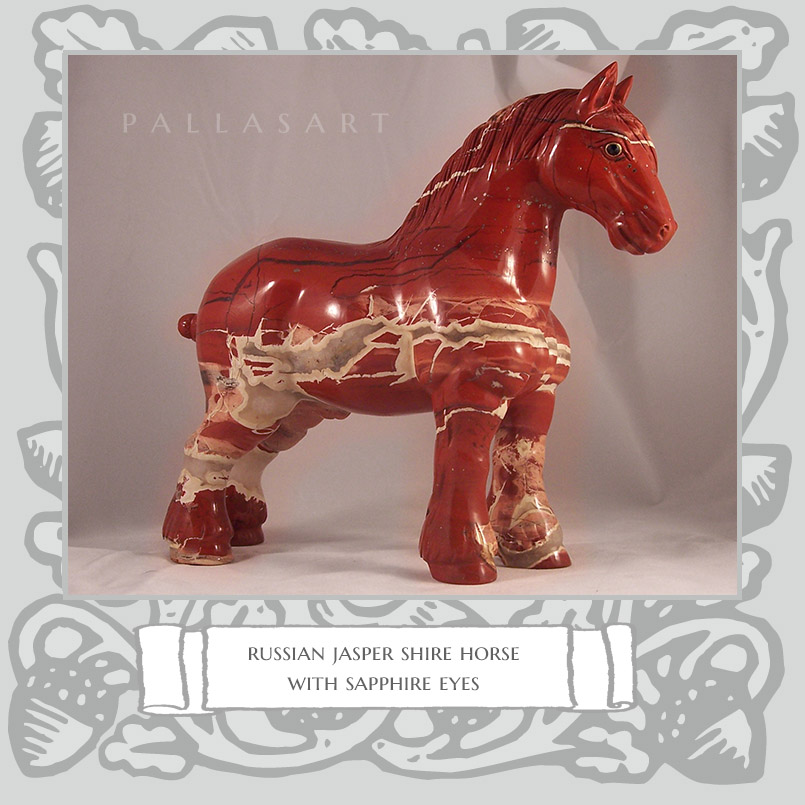
Russian Jasper Shire Horse with Sapphire Eyes
After I placed y order for my horses this was the first one to arrive. They are all just about the same size, but there is some variation. The stone this horse is carved in is really interesting and came from Yekaterinburg in the Ural Mountains. Brecciated Jasper, an aggregate of microgranular quartz and/or chalcedony and other mineral phases, is an opaque, impure variety of silica, usually red, yellow, brown or green in color; and rarely blue. The common red color is due to iron inclusions. It has waves and areas of clear and translucent quartz running though it. There are also veins of color. The eyes are faceted sapphire eyes set in gold collets. This horse is really dramatic, I find myself picking it up and moving it around in my hands a lot. I was really lucky 21 years ago to travel to the Urals and visit jasper mines there. I tried to make contact with lapidary works there - in the 18-19th centuries the Urals were the center of the production of vases and columns in jaspers that were mined there. I was not successful in getting any jasper vases on neoclassical forms (like you see on the upper right). Alas, the art of vase turning in this style is now dead. I tried to have the Chinese make these and they all broke in production and we had to give up trying to make them. The type of jasper used in this horse is the same jasper found in the agate pavilion of Catherine the Great at Tsarskoe Selo. That makes it extra special to me and I am glad I have this specimen in the same stone here in my collection.
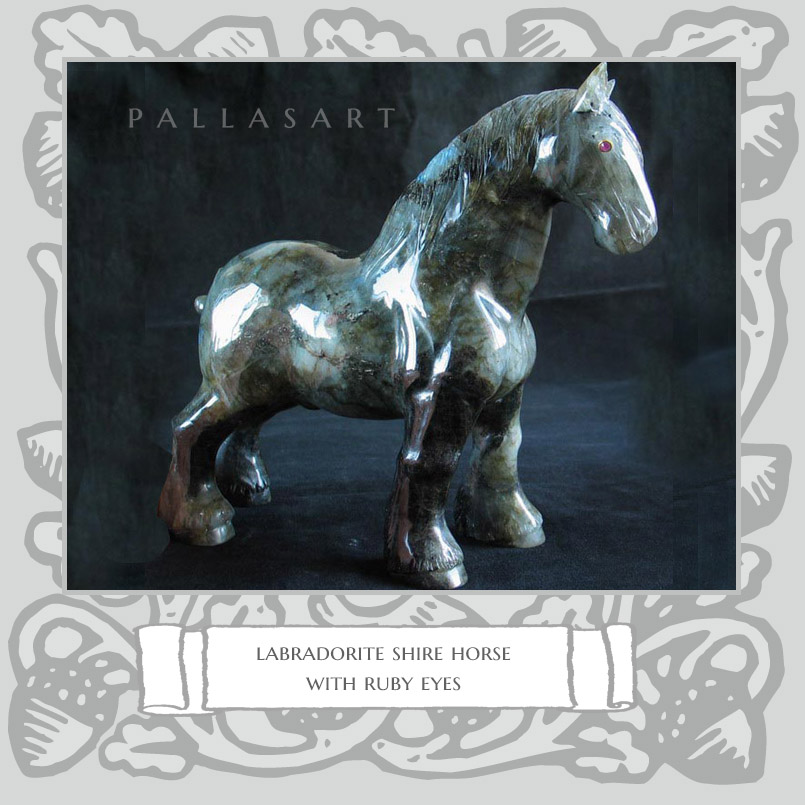
Labradorite Shire Horse with Ruby Eyes in Gold Collots
Of all of my stone animals this one is the most dramatic. I first encountered Labradorite in 1976 o my first trip to Russia. I was in Red Square in the queue to see Lenin in his tomb, when I got up to the door I saw the tomb was sheathed in panels of a a dark black stone that flashed blue in the sun. I knew the tomb had been built by the Art-Nouveau (Style Moderne in Russia) architect Aleksey Shchusev, who also designed the church in the Moscow convent, Martha and Mary, that was built by Grand Dutchess Elizeth, the sister of Empress Alexandra. Labradorite is a felspar mineral. Labradorite can display an iridescent optical effect (or schiller) known as labradorescence. You cannot understand how beautiful - and unearthly - this stone is unless you have seen and touched it.
Labradorite is a considered gemstone that was named after Labrador in Canada, where it was found on the Isle of Paul, near Nain in 1770. It has since been found in other places, including Finland, Madagascar, and Australia. The Labradorite on Lenin's Tomb came from Finland. I have a small table top make of this stone and around a dozen hardstone eggs plus 5-6 other animals. This horse has so much schiller it appears like lightening is flashing in it. A better analogy is the aurora borealis - which is appropriate considering where the best specimens come from the far north. When you walk by this horse the flashes go off all over the piece, I think this photograph depicts that effect pretty well. This was the most difficult of all of the animals I made in China to carve. The stone has many defects and even cracks in it. It fractures easily. The guys who carved my horses did not want to carve them without a base left on. Carving out the space from leg to leg - without a support or brace - meant a few of them broke in production. The ruby eyes are pretty pretty and the gold collot adds a lot of richness. Of all the horses we carved, this one is my favorite.

Black Obsidian Shire Horse with Ruby Eyes in Gold Collots
I wanted to have a horse made from Mahogany or Snowflake Obsidian so it would have a beautiful color or pattern in the stone, but the carvers weren't able to find any locally, only a plain black variety in the size required. I am not sure Obsidian is a very popular stone in China, black Jadeite and nephrite is easy to find there and they are more comfortable carving an polishing using those stones. The carvers were always surprised when I asked them to carve an animal in a specific stone, oftentimes we had to find the Chinese name for a stone to identify it and had a block of it to carve from. Obsidian is a naturally occurring volcanic glass formed as an extrusive igneous rock. Obsidian is produced when felsic lava extruded from a volcano cools rapidly with minimal crystal growth. Obsidian is very hard and brittle and fractures with very shape edges. There's a lot of it in America and I grew up with it in the Pacific Northwest, where I grew up. We used to find blades and arrow heads made from it. The ruby eyes on this horse are faceted.
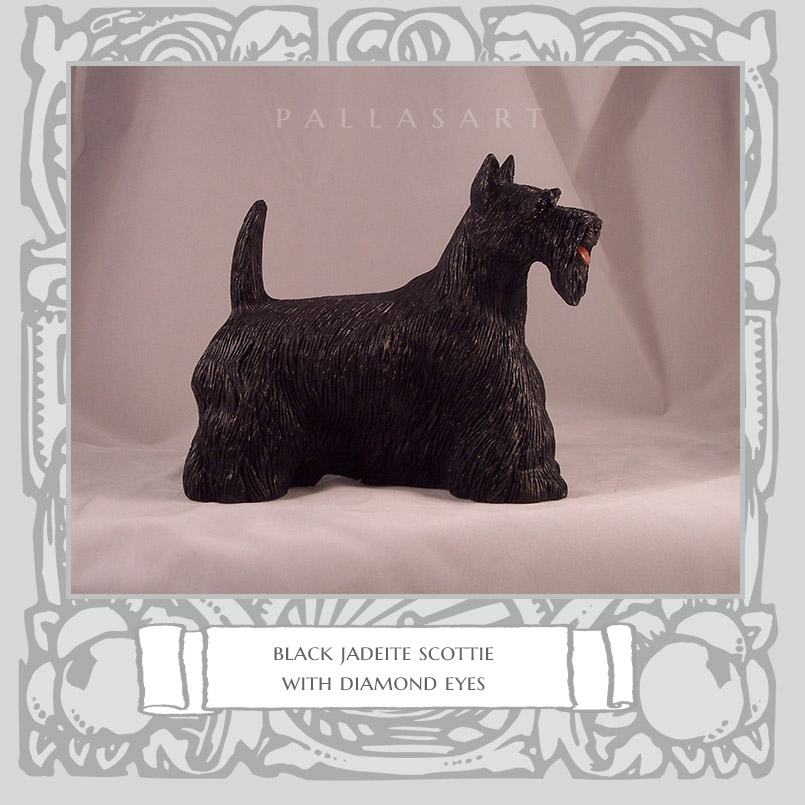
Black Jadeite Scottie Dog with Diamond Eyes
This Scottie is around 4 inches long and has a red jasper tongue. I had her carved because I have had 4 Scottie dogs as pets over the years. The last one was named Lillie Langtry and she passed away two years ago. I was going to have a silver collar made for this dog, but never could find someone to do it. I now plan to make a collar from small emerald and gold beads. I will post a picture after I have done it.
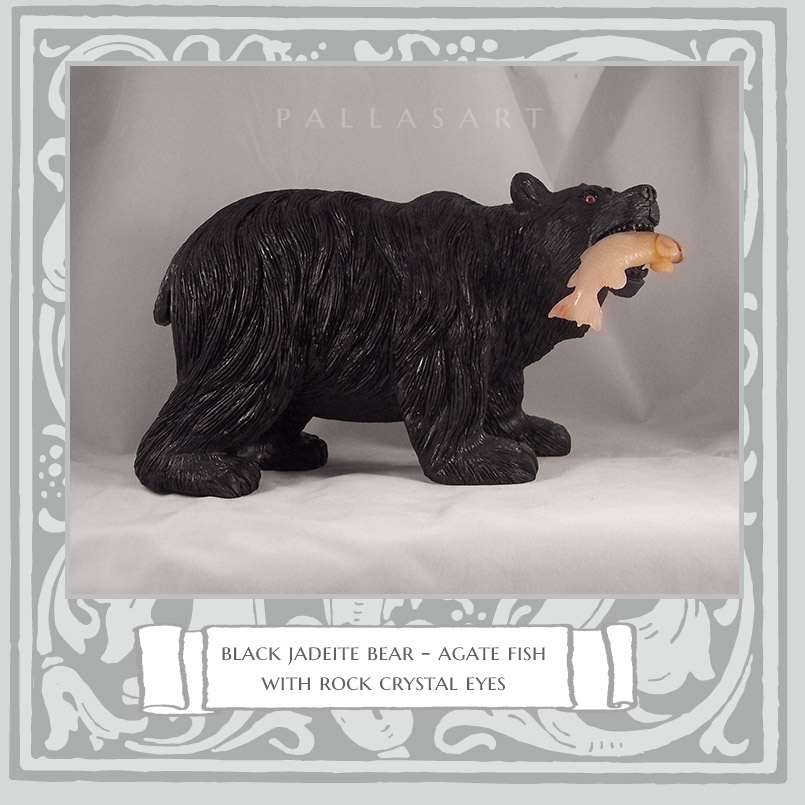
Black Jadeite Bear Holding Agate Fish with Rock Crystal Eyes
This is the largest animal in my collection, she is part of a pair of bears, the second one isn't holding a fish. The first hardstone animals I collected were the famous bear and fish that you see everywhere made from a variety of stones. I have 20 of those small bears in various stones. My first one was in carved in Rhodonite from Victoria Island near Vancouver in Canada. Pink Rhodonite is one of my absolutely favorite stones - you can see it in the tazza on the right. Some of the best stone comes from Russia. I mentioned earlier that I tried to make hardstone vases in China. I tried to make six pair in Rhodonite in the same shape as the tazza. That's 12 blocks of stone we had to get and ship from Canada. All of them broke and I didn't get a single vase. I think the problem was the Chinese didn't have the right equipment to 'turn' these like the Russians used to do so well. As each example broke I decided to try try again, it was very frustrating for the carvers, imagine how they felt seeing their work destroyed. They all broke at the same place, at the narrowest part of the neck. I am sure part of the problem was the Rhodonite was fracturing because it's the nature of that stone. The Russians spent a year or more to turn one vase - they were masters at it, that's for sure! Also, I think we should have made them in parts and glued them together or attached the pieces with invisible screws. This bear has a somewhat comical expression - both bears have it. As I mentioned earlier I had to constantly fight the tendency of the carvers to make the animals cute or funny. Actually, the Russians were worse than the Chinese in this regard. The Russians wanted to add hats and vodka bottles to their bears - however, one must confess that Fabergé did the same thing.

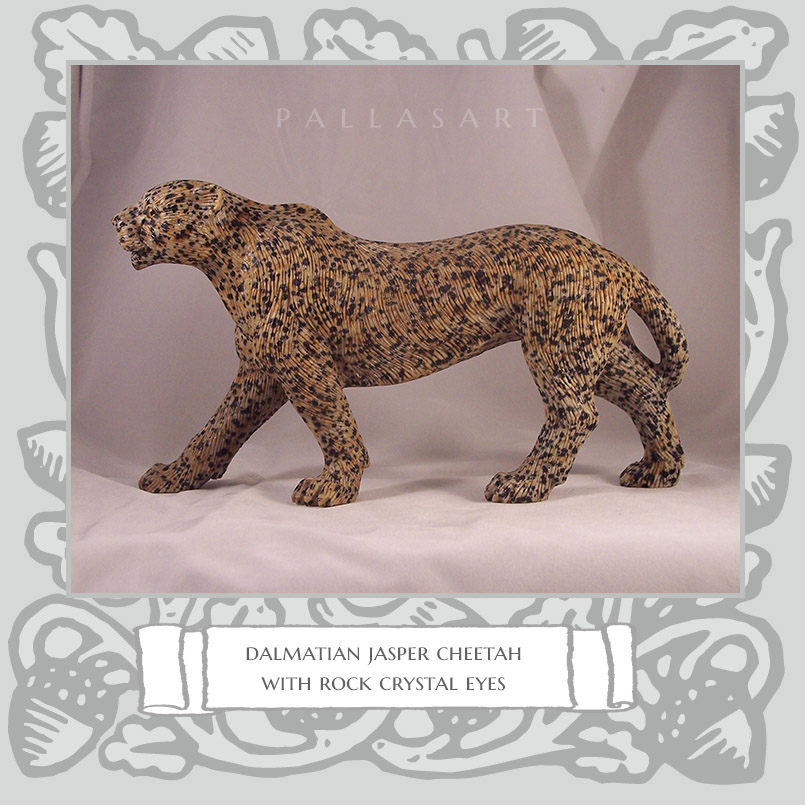




























 New Home Builder Website Checklist
New Home Builder Website Checklist 












